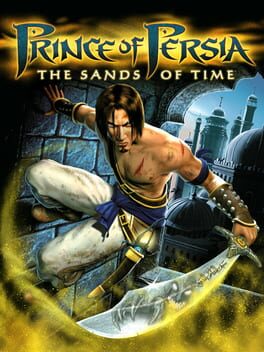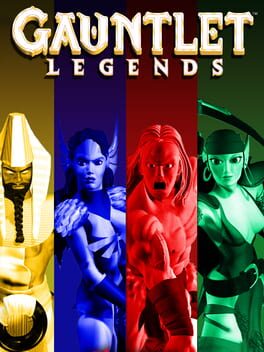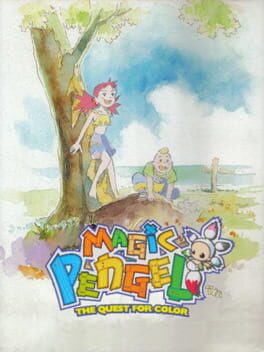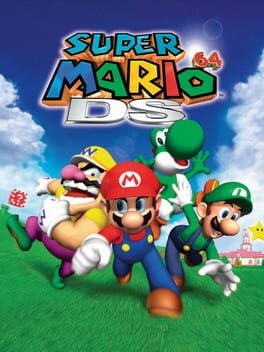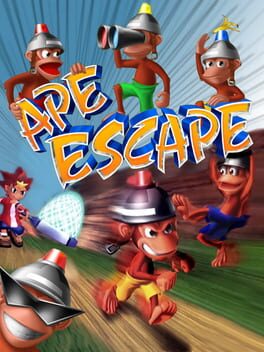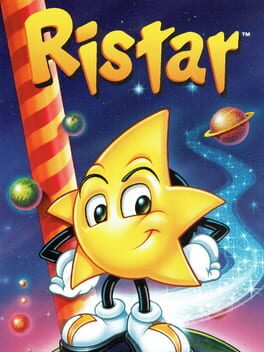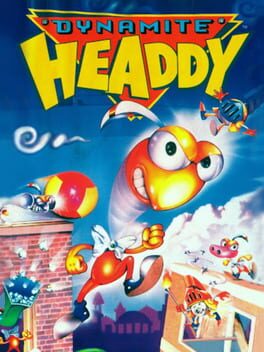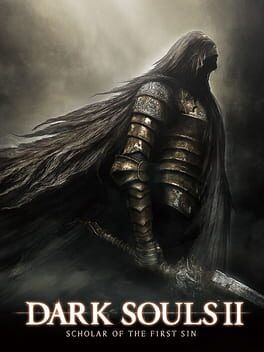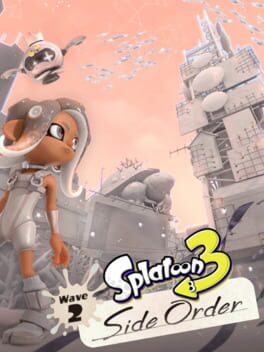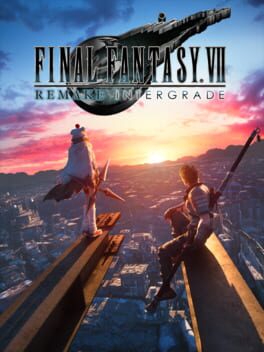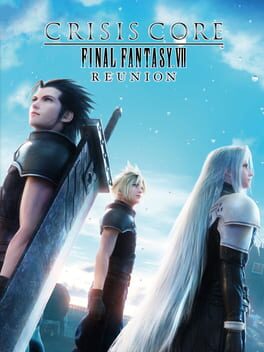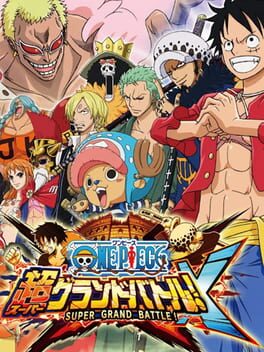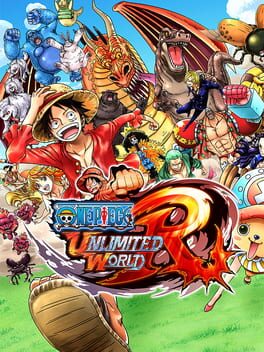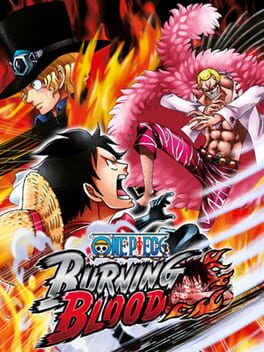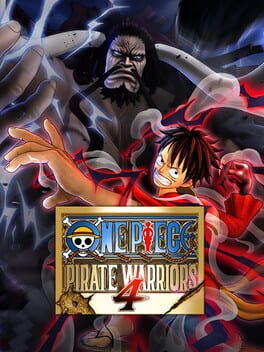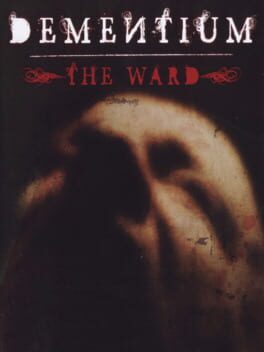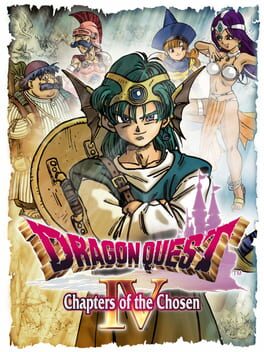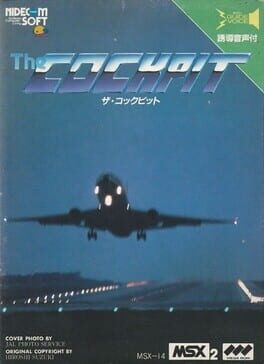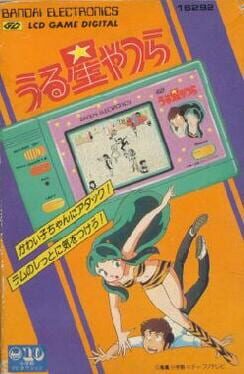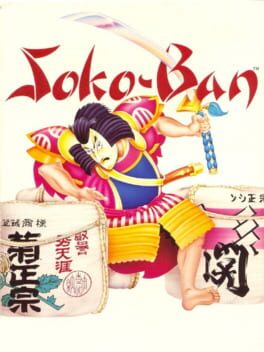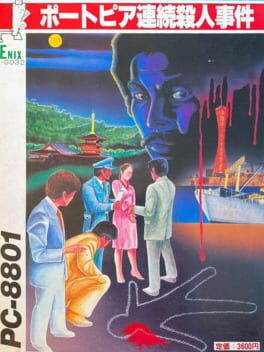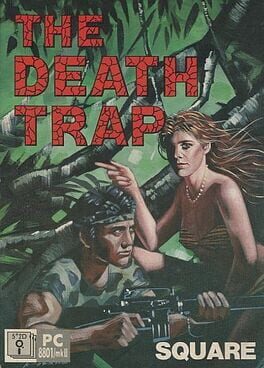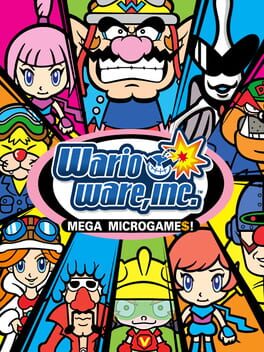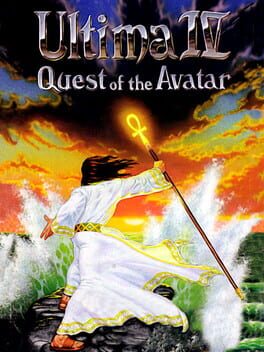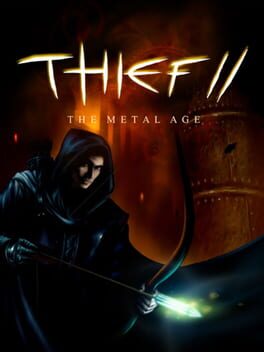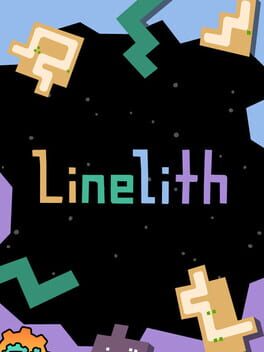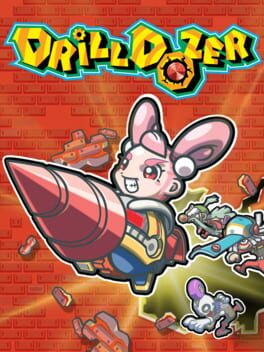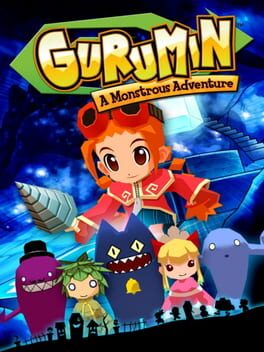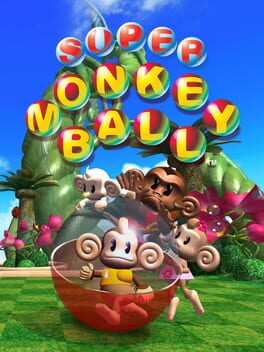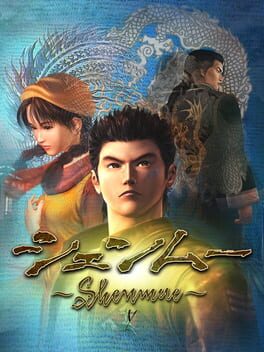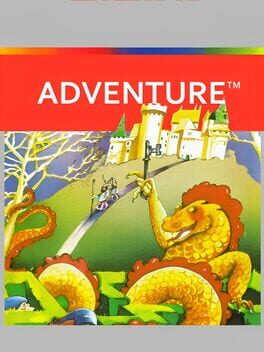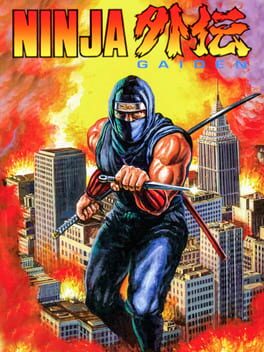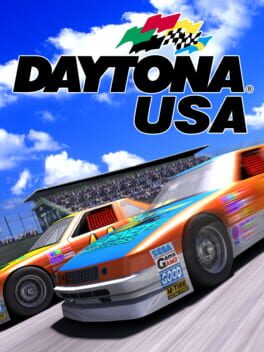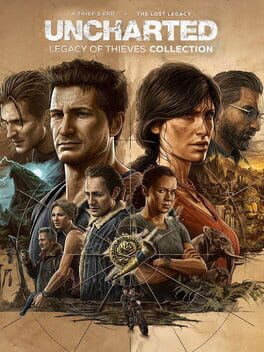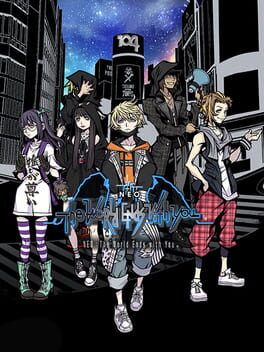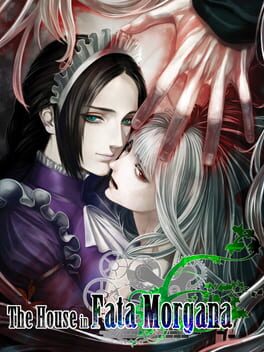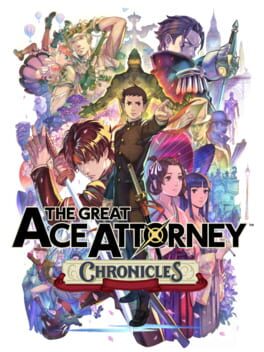PolaroidJack
BACKER
373 reviews liked by PolaroidJack
Before playing this, I had very little exposure to Prince of Persia. I knew it was a series of action platformers. I knew there was a bad movie adaptation of it. I remember really wanting to play Warrior Within since the cover for the Gamecube version looked super cool and edgy, but my parents wouldn't let elementary school me buy it, so I ended up playing games like Chibi-Robo and Animal Crossing instead. I played maybe 20 minutes of the Wii version of Forgotten Sands a while back. That's about it. I only ended up playing this game now because I wanted to play at least one of the older Prince of Persia titles before diving into Lost Crown. Although I do think Sands of Time has some pretty big flaws, I do want to preface this by saying I had an absolutely great time playing it. This might be the recency bias talking, but this could easily be up there with something like the original Dragon's Dogma on my list of "best 7/10 games you'll ever play". A good two thirds of the game is made up of what would now be mockingly referred to as "uncharted climbing", there's a certain deliberateness to all of your actions that still makes it enjoyable. Most of the game's challenges boil down to having to figure out how to traverse a room or outdoor area, then actually timing things like pole swings and wall jumps to make it happen. Simply having to do things like press a button to raise yourself up or drop down a ledge, or not being able to stand up on a pole you can swing on and instead having to turn around, swing, then jump against the wall in order to get to a pole directly above you are satisfying enough to keep platforming interesting. Using the dagger to rewind time mostly seemed like a gimmick to me thanks to the fast load times and incredibly generous checkpointing of the PC release, but then I got to the point near the end of the game where you have to climb a large tower without it and I realized just how nice it was to be able to undo one bad jump or something without having to go through the whole sequence again.
The combat is rather simple, though not because of the Prince's moveset. You have a basic melee combo, a block and parry, several abilities tied to the Dagger of Time, and a few acrobatic moves such as a lunge that's performed by jumping against a wall or vaulting over an enemy to attack them from behind. I do quite like how most enemies don't actually die unless you stab them with the dagger while they're down ( a pretty clear inspiration for the systems used by games like Assasin's Creed or the Arkham series where you have to confirm takedowns) and the enemy variety is nice, but there are two things that hold the combat sections back. The first is that most enemies have one attack that's always the best way to deal with them. Use the lunge against the two-sided spearmen or the big guys with swords. Vault over the female enemies with two swords and the big hammer guys. You can vary this up, especially with the parry, but it always feels like you're just drawing out encounters in order to use cool moves that are weaker than the best option. The second issue is the encounter design itself. Fights are mostly limited to open spaces and enemies come at you in groups of three or four. Kill an enemy, and another one will spawn in to take its place. Repeat this 15 or 20 times. Now I get that that's probably due to hardware limitations, but it really makes fights feel like they're artificially dragged out when you just keep cutting down enemies and exact copies of them appear out of nowhere like there's a spectral clown car just driving around the arena. I also get that the development team didn't want the game to be like 90% platforming so they needed to put more combat encounters in the game, but doing something like putting some enemies in the mostly empty hallways of the palace, or even just putting some traps in the arenas and letting you use them on the enemies could have gone a long way.
As far as presentation goes, the game holds up pretty well. The art direction and the way that the Prince grows more disheveled as the game goes on really sell it, and Yuri Lowenthal's performance is easily a high point in his career. He manages to sell the Prince as both a cocky noble seeking glory and as someone who's in way over his head and who knows it. I particularly like the narration of the Prince retelling the story of the game to Farah and the parts where you fail and he goes "No no no, I jumped over the bridge" or things like that. The music was generally fine, but there were a few standout tracks. A lot of it is a kind of mix of metal music and stereotypically Arabian music. I really wish there were more tracks that leaned into using vocals like The Tower of Dawn or Discover the Royal Chambers, though. The story itself was decent enough, but I felt like Farah as a character was pretty bland and her romance with the Prince was forced to the point that I honestly couldn't tell if she was actually into him or just seduced him to steal the dagger near the end (it seems like she only did this because he hesitated the first time they got to the hourglass, but IDK). For like half of the game I couldn't even remember her name and just thought of her as the girl who pulled switches. I do like the overall story of the Prince letting his pride get the better of him and making a terrible mistake that he then has to try and fix, though. It's very much a tragic tale in the classical sense of the word.
The PC port was surprisingly stable considering this is just a game from 2003, but I did have two issues with it. First was that the fog effects are just fucked to the point of completely covering the screen in the stuff. Thankfully the fog can just be turned off, but I don't really know how much that impacts the atmosphere of the game since I played through the whole thing without any fog. Second was that a lot of the dialogue from Farah during gameplay was super quiet, almost to the point of being unintelligible. This seemed like some kind of positional audio thing, but I can't say for sure since there were times where I could barely hear even though she was like three feet away from the Prince. It was still pretty painless for an older title, though, since I didn't have to really mess with compatibility or fan patches or any of the other tinkering that you normally have to do to make a game like this run on modern hardware. Considering I mostly played this game on a whim and got it for like $2 in a Steam sale, I'm really glad I played it. I'm looking forward to playing the other PoP games in the future, particularly Warrior Within. I want to see if it's really as edgy as the box art suggests.
The combat is rather simple, though not because of the Prince's moveset. You have a basic melee combo, a block and parry, several abilities tied to the Dagger of Time, and a few acrobatic moves such as a lunge that's performed by jumping against a wall or vaulting over an enemy to attack them from behind. I do quite like how most enemies don't actually die unless you stab them with the dagger while they're down ( a pretty clear inspiration for the systems used by games like Assasin's Creed or the Arkham series where you have to confirm takedowns) and the enemy variety is nice, but there are two things that hold the combat sections back. The first is that most enemies have one attack that's always the best way to deal with them. Use the lunge against the two-sided spearmen or the big guys with swords. Vault over the female enemies with two swords and the big hammer guys. You can vary this up, especially with the parry, but it always feels like you're just drawing out encounters in order to use cool moves that are weaker than the best option. The second issue is the encounter design itself. Fights are mostly limited to open spaces and enemies come at you in groups of three or four. Kill an enemy, and another one will spawn in to take its place. Repeat this 15 or 20 times. Now I get that that's probably due to hardware limitations, but it really makes fights feel like they're artificially dragged out when you just keep cutting down enemies and exact copies of them appear out of nowhere like there's a spectral clown car just driving around the arena. I also get that the development team didn't want the game to be like 90% platforming so they needed to put more combat encounters in the game, but doing something like putting some enemies in the mostly empty hallways of the palace, or even just putting some traps in the arenas and letting you use them on the enemies could have gone a long way.
As far as presentation goes, the game holds up pretty well. The art direction and the way that the Prince grows more disheveled as the game goes on really sell it, and Yuri Lowenthal's performance is easily a high point in his career. He manages to sell the Prince as both a cocky noble seeking glory and as someone who's in way over his head and who knows it. I particularly like the narration of the Prince retelling the story of the game to Farah and the parts where you fail and he goes "No no no, I jumped over the bridge" or things like that. The music was generally fine, but there were a few standout tracks. A lot of it is a kind of mix of metal music and stereotypically Arabian music. I really wish there were more tracks that leaned into using vocals like The Tower of Dawn or Discover the Royal Chambers, though. The story itself was decent enough, but I felt like Farah as a character was pretty bland and her romance with the Prince was forced to the point that I honestly couldn't tell if she was actually into him or just seduced him to steal the dagger near the end (it seems like she only did this because he hesitated the first time they got to the hourglass, but IDK). For like half of the game I couldn't even remember her name and just thought of her as the girl who pulled switches. I do like the overall story of the Prince letting his pride get the better of him and making a terrible mistake that he then has to try and fix, though. It's very much a tragic tale in the classical sense of the word.
The PC port was surprisingly stable considering this is just a game from 2003, but I did have two issues with it. First was that the fog effects are just fucked to the point of completely covering the screen in the stuff. Thankfully the fog can just be turned off, but I don't really know how much that impacts the atmosphere of the game since I played through the whole thing without any fog. Second was that a lot of the dialogue from Farah during gameplay was super quiet, almost to the point of being unintelligible. This seemed like some kind of positional audio thing, but I can't say for sure since there were times where I could barely hear even though she was like three feet away from the Prince. It was still pretty painless for an older title, though, since I didn't have to really mess with compatibility or fan patches or any of the other tinkering that you normally have to do to make a game like this run on modern hardware. Considering I mostly played this game on a whim and got it for like $2 in a Steam sale, I'm really glad I played it. I'm looking forward to playing the other PoP games in the future, particularly Warrior Within. I want to see if it's really as edgy as the box art suggests.
Gauntlet Legends
1998
podcast fodder. it occurred to me over the course of playing that for four-player couch co-op like this, the mindlessness is a boon. you're supposed to be catching up with your friends and fucking around, not actually invested in the game.
it pulls surprisingly heavily from the original gauntlet with little variation: destroy generators that endlessly spawn, open chests and gates with keys, use potions as AoEs, destroy walls, open other walls. the only other mechanical changes is some light meter management, where you can activate one of three different special abilities depending on the level of the gauge or siphon some off to use a dash-twirl kinda action. other than weaving those in, you'll just be mashing the shoot/attack button, and with the advent of a 3D world and shifting perspective for the game, they've slathered auto-aim all over your toolkit, so there's almost no engagement other than being there to press the button... and if you're close enough to an enemy you'll auto-attack anyway, so who cares.
the main intrigue instead are the variety of environments and stages, each with their own hazards and puzzles to solve. you might rend an arena asunder by pressing a switch, skewing the two halves apart and exposing new corridors in the process. there's moments where you'll rearrange a set of catwalks by pressing a series of switches (although you never have access to more than one at once) to raise and lower them to match your character's height. in some (many) instances, you must painstakingly root out a breakable wall and enter it to press a switch and open a different wall somewhere else. indeed, most of the game consists of finding switches to press to access a new area; it is not uncommon for there to be chains of three to seven switches that lead to each other in the span of a single room. is what the switches activate occasionally cool, giving you a new path through the often intricate area designs? sure. but expect the whole game to follow virtually the exact same loop throughout: mash attack, press switch.
there's occasional gesturing to more of diablo-like system, the style which would quickly eat this series' lunch by the sixth gen, though it often doesn't land given the game's arcade-focused nature. other than adding a leveling and stats system to the original gauntlet experience, there's also this odd loot/power-up component, some of which is random but others of which are actually specific, often obscure unlockables within particular levels. of course, seeing as there's no permanence regarding items beyond keys/potions, these end up being temporary powerups; the thrill of grinding out skorne 1 so that you can get a piece of his armor set feels quaint when faced with the reality that said item will disappear 90 seconds into the next stage you play. as an aside: per the original game you're intended to replenish your health or revive yourself with extra credits, but seeing as this console version does not have that system, dying will kick you back out to the hub with whatever health you had going in. that might seem fine, but if you actually want to replenish to full health, expect to spend a lot of time grinding the first level for the 400-500 in health pickups that are guaranteed. for my final boss run, where I needed my level 60 max of 7000 health after spending most of the game maintaining about 2000, this was quite a chore.
this sega dreamcast version seems like a hodge-podge of each of the other versions of this game. compared to the playstation and n64 versions, which have a different set of levels and a proper inventory system, the dreamcast version serves as a more direct port of the original's levels and item system. oddly enough, it does have the additional endgame levels and skorne refight from the original home ports. it also carries in certain mechanical changes from the game's incremental sequel dark legacy, such as all of the new character classes and a functionally useless block ability; what the fuck is the point of a block in a mostly ranged game where having attack advantage is always a priority to avoid getting flanked and overwhelmed? probably the most bizarre aspect of the dreamcast version is that it runs like dogshit even with only a single player, and it retains the somewhat hideous look of the original game. not sure why the dc wasn't able to handle a relatively low-poly game built for a 3DFX banshee gpu, but I'm going to assume fault on the part of the developers.
still, a podcast game with some cool level visuals has its own appeal. was unfortunately left curious about dark legacy and the later gameplay revisions in seven sorrows. an arcade-style dungeon crawler does appeal to me in a base way, and I appreciate that this was an early attempt at creating an arcade game with a proper progression system (including rudimentary usernames and passwords!). should probably bring some friends along for the ride if I ever get a wild hair to try again.
it pulls surprisingly heavily from the original gauntlet with little variation: destroy generators that endlessly spawn, open chests and gates with keys, use potions as AoEs, destroy walls, open other walls. the only other mechanical changes is some light meter management, where you can activate one of three different special abilities depending on the level of the gauge or siphon some off to use a dash-twirl kinda action. other than weaving those in, you'll just be mashing the shoot/attack button, and with the advent of a 3D world and shifting perspective for the game, they've slathered auto-aim all over your toolkit, so there's almost no engagement other than being there to press the button... and if you're close enough to an enemy you'll auto-attack anyway, so who cares.
the main intrigue instead are the variety of environments and stages, each with their own hazards and puzzles to solve. you might rend an arena asunder by pressing a switch, skewing the two halves apart and exposing new corridors in the process. there's moments where you'll rearrange a set of catwalks by pressing a series of switches (although you never have access to more than one at once) to raise and lower them to match your character's height. in some (many) instances, you must painstakingly root out a breakable wall and enter it to press a switch and open a different wall somewhere else. indeed, most of the game consists of finding switches to press to access a new area; it is not uncommon for there to be chains of three to seven switches that lead to each other in the span of a single room. is what the switches activate occasionally cool, giving you a new path through the often intricate area designs? sure. but expect the whole game to follow virtually the exact same loop throughout: mash attack, press switch.
there's occasional gesturing to more of diablo-like system, the style which would quickly eat this series' lunch by the sixth gen, though it often doesn't land given the game's arcade-focused nature. other than adding a leveling and stats system to the original gauntlet experience, there's also this odd loot/power-up component, some of which is random but others of which are actually specific, often obscure unlockables within particular levels. of course, seeing as there's no permanence regarding items beyond keys/potions, these end up being temporary powerups; the thrill of grinding out skorne 1 so that you can get a piece of his armor set feels quaint when faced with the reality that said item will disappear 90 seconds into the next stage you play. as an aside: per the original game you're intended to replenish your health or revive yourself with extra credits, but seeing as this console version does not have that system, dying will kick you back out to the hub with whatever health you had going in. that might seem fine, but if you actually want to replenish to full health, expect to spend a lot of time grinding the first level for the 400-500 in health pickups that are guaranteed. for my final boss run, where I needed my level 60 max of 7000 health after spending most of the game maintaining about 2000, this was quite a chore.
this sega dreamcast version seems like a hodge-podge of each of the other versions of this game. compared to the playstation and n64 versions, which have a different set of levels and a proper inventory system, the dreamcast version serves as a more direct port of the original's levels and item system. oddly enough, it does have the additional endgame levels and skorne refight from the original home ports. it also carries in certain mechanical changes from the game's incremental sequel dark legacy, such as all of the new character classes and a functionally useless block ability; what the fuck is the point of a block in a mostly ranged game where having attack advantage is always a priority to avoid getting flanked and overwhelmed? probably the most bizarre aspect of the dreamcast version is that it runs like dogshit even with only a single player, and it retains the somewhat hideous look of the original game. not sure why the dc wasn't able to handle a relatively low-poly game built for a 3DFX banshee gpu, but I'm going to assume fault on the part of the developers.
still, a podcast game with some cool level visuals has its own appeal. was unfortunately left curious about dark legacy and the later gameplay revisions in seven sorrows. an arcade-style dungeon crawler does appeal to me in a base way, and I appreciate that this was an early attempt at creating an arcade game with a proper progression system (including rudimentary usernames and passwords!). should probably bring some friends along for the ride if I ever get a wild hair to try again.
I will be upfront here and admit that my initial impression of Magic Pengel was underwhelming. The first couple of hours felt extremely plodding, thanks to the opening glut of story cutscenes with awkward voice acting, the lack of part variety to attach to your Doodles (your drawable monsters for battle), and the initial grind for more colors necessary to both draw and further develop your Doodles. This initial grind can be a nightmare because a lot of the fightable villagers will easily outclass you in terms of sheer stats and stall you out by using Charge every other turn to heal off more damage than you can inflict, so you’ll end up wasting your arena time if you happen to challenge a super tough villager since there’s also no way to forfeit a match. It also doesn’t help that there’s a half minute loading screen every time you need to move to a new area in the overworld, so you’ll end up sitting through over a minute of loading screens moving between the two main arenas alone since there’s no fast travel and you’ll have to pass through the market every time. Not a great start for a seemingly great premise!
Get past this initial roadblock by winning a few arena matches and gaining enough resources to thoroughly flesh out your Doodles with better stats, however, and the game starts to find its footing. Combat is almost entirely turn-based rock-paper-scissors (magic trumps attack, attack trumps block, block trumps magic) with some degree of mind games. This fortunately does get a bit more complex later on; landing magic spells can inflict status effects such as paralysis and sleep upon foes, as well as temporarily lock or punish types of attacks depending on the spell used. This essentially adds another layer to the mind games, aside from the aforementioned Charge for healing/powering-up the next attack/resetting neutral; thus, combat isn't just mindlessly following the advantage triangle specified above. In addition, the colors and parts used (i.e. adding limbs, wings, a held weapon, etc) drastically change both your stat and skill distribution (explained in more detail here and here ), and since your drawing capabilities and max capacity are increased with each arena win, you’ll likely be redrawing your Doodles all the time anyways to keep up with the tougher fights while tinkering with new and expanded loadouts. Simultaneously, it becomes a lot easier to farm resources since your Doodles will finally have enough attack power to deal more damage than opponents can heal off with Charge, and you’ll earn significantly more of each color (a few thousand as opposed to a few hundred in the early game) upon victories. While Magic Pengel’s combat never reaches the depth of similar monster battling systems such as Pokemon, I nevertheless found it easy enough to get into the rhythm of the progression loop once I got past the opening grind, and it served as a solid podcast game that vaguely reminded me of my days laddering on Pokemon Showdown.
A word of warning though: as much fun as it is sketching crude creatures with your Pengel and watching your crayon abominations destroy developer-drawn Doodles with much more effort put into sketching, that is unfortunately just about all that this game has to offer. Magic Pengel’s narrative touches upon some interesting lore and story beats concerning both the world of color and the supporting cast (such as your friend Zoe’s connection with her missing foster father, a renowned Doodler that once worked for the king), but the game never goes into too much detail with its sparse storytelling, and it ends on a bit of a cliffhanger as your friends decide to set off on another adventure. While you can sell spare colors for gold gems, there’s not much to purchase from shopkeepers; you can buy a few brushes to further adjust your line thickness, but the only other items on offer are Doodles, and there’s no point in buying those when you’ll get far more utility out of drawing your own (especially because you can’t delete any part of a Doodle drawn by an NPC). Finally, the game is a bit lacking in post-game content. The only unlocked features are a new arena where you can engage in 1 v 3 or 2 v 3 fights for higher rewards, as well as a hidden boss that can be fought if you somehow grind one million gold gems. As such, I have to concede that a lot of the Magic Pengel’s surrounding elements could have used some more time in the oven.
Ultimately, I prefer the game’s spiritual successor Graffiti Kingdom for its more succinct runtime and expanded drawing utensils. Even so, I mostly enjoyed my time with Magic Pengel (the quaint charm and artstyle admittingly a big reason why), and I’d say it’s worth checking out if you want a taste of one of more creative monster collecting/creating games out there. I think Taito had something really special on their hands with this formula, and it’s a shame we’ll never see a game in this vein from them again.
Get past this initial roadblock by winning a few arena matches and gaining enough resources to thoroughly flesh out your Doodles with better stats, however, and the game starts to find its footing. Combat is almost entirely turn-based rock-paper-scissors (magic trumps attack, attack trumps block, block trumps magic) with some degree of mind games. This fortunately does get a bit more complex later on; landing magic spells can inflict status effects such as paralysis and sleep upon foes, as well as temporarily lock or punish types of attacks depending on the spell used. This essentially adds another layer to the mind games, aside from the aforementioned Charge for healing/powering-up the next attack/resetting neutral; thus, combat isn't just mindlessly following the advantage triangle specified above. In addition, the colors and parts used (i.e. adding limbs, wings, a held weapon, etc) drastically change both your stat and skill distribution (explained in more detail here and here ), and since your drawing capabilities and max capacity are increased with each arena win, you’ll likely be redrawing your Doodles all the time anyways to keep up with the tougher fights while tinkering with new and expanded loadouts. Simultaneously, it becomes a lot easier to farm resources since your Doodles will finally have enough attack power to deal more damage than opponents can heal off with Charge, and you’ll earn significantly more of each color (a few thousand as opposed to a few hundred in the early game) upon victories. While Magic Pengel’s combat never reaches the depth of similar monster battling systems such as Pokemon, I nevertheless found it easy enough to get into the rhythm of the progression loop once I got past the opening grind, and it served as a solid podcast game that vaguely reminded me of my days laddering on Pokemon Showdown.
A word of warning though: as much fun as it is sketching crude creatures with your Pengel and watching your crayon abominations destroy developer-drawn Doodles with much more effort put into sketching, that is unfortunately just about all that this game has to offer. Magic Pengel’s narrative touches upon some interesting lore and story beats concerning both the world of color and the supporting cast (such as your friend Zoe’s connection with her missing foster father, a renowned Doodler that once worked for the king), but the game never goes into too much detail with its sparse storytelling, and it ends on a bit of a cliffhanger as your friends decide to set off on another adventure. While you can sell spare colors for gold gems, there’s not much to purchase from shopkeepers; you can buy a few brushes to further adjust your line thickness, but the only other items on offer are Doodles, and there’s no point in buying those when you’ll get far more utility out of drawing your own (especially because you can’t delete any part of a Doodle drawn by an NPC). Finally, the game is a bit lacking in post-game content. The only unlocked features are a new arena where you can engage in 1 v 3 or 2 v 3 fights for higher rewards, as well as a hidden boss that can be fought if you somehow grind one million gold gems. As such, I have to concede that a lot of the Magic Pengel’s surrounding elements could have used some more time in the oven.
Ultimately, I prefer the game’s spiritual successor Graffiti Kingdom for its more succinct runtime and expanded drawing utensils. Even so, I mostly enjoyed my time with Magic Pengel (the quaint charm and artstyle admittingly a big reason why), and I’d say it’s worth checking out if you want a taste of one of more creative monster collecting/creating games out there. I think Taito had something really special on their hands with this formula, and it’s a shame we’ll never see a game in this vein from them again.
Super Mario 64 DS
2004
nintendo salvaging the american gaming market with the release of the NES was the modern inflection point for our industry, in some ways that are less obvious than others. the console enshrined gaming as a medium with legitimacy beyond the original fad-like relevance of the atari VCS, but the centralization of this success around nintendo gave the company an uncomfortable amount of leverage. this immediately portended poorly with the simultaneous release of the console's killer app: super mario bros., which gestured to a sinister rejection of the console's original intent. look to the japanese launch line-up and you'll see arcade staples such as donkey kong and popeye; games that lauded precise, restricted play with definitive rules and short runtimes. super mario bros. was a refutation of this design philosophy in favor of the loosey-goosey variable jump heights, frequent health restoration items, and long hallways of copy-paste content replacing the tightly paced experiences that defined the era before. the NES still featured arguably the greatest console expressions of the rigorous arcade action experiences that defined the '80s - castlevania, ninja gaiden, and the early mega mans all come to mind - but the seeds super mario bros. planted would presage a shift into more and more experiences that coddled the player rather than testing their fortitude. in some ways, super mario bros. lit the match that would leave our gaming landscape in the smoldering ruins of the AAA design philosophy.
the '90s only deepened nintendo's exploration of trends that would further attempt to curb the arcade philosophy, which still floated on thanks to the valiant efforts of their competitors at sega, capcom, konami, and others. super mario world kicked off nintendo's 16-bit era with an explicitly non-linear world map that favored the illusion of charting unknown lands over the concrete reality of learning play fundamentals, and its pseudo-sequel yoshi's island would further de-emphasize actual platforming chops by giving the player a generous hover and grading them on their ability to pixel hunt for collectables rather than play well, but the most stunning example of nintendo's decadence in this era is undoubtedly donkey kong '94. the original donkey kong had four levels tightly wound around a fixed jump arc and limited ability for mario to deal with obstacles; its ostensible "remake" shat all over its legacy by infusing mario's toolkit with such ridiculous pablum such as exaggerated flip jumps, handstands, and other such acrobatics. by this point nintendo was engaging in blatant historical revisionism, turning this cornerstone of the genre into a bug-eyed circus romp, stuffed with dozens of new puzzle-centric levels that completely jettisoned any semblance of toolkit-oriented level design from the original game. and yet, this was the final fissure before the dam fully burst in 1996.
with the release of the nintendo 64 came the death knell of the industry: the analog stick. nintendo's most cunning engineers and depraved designers had cooked up a new way to hand unprecedented control to the player and tear down all obstacles standing in the way of the paternalistic head-pat of a "job well done" that came with finishing a game. with it also came this demonic interloper's physical vessel, super mario 64; the refined, sneering coalescence of all of nintendo's design tendencies up to this point. see here a game with enormous, previously unfathomable player expression, with virtually every objective solvable in myriad different ways to accommodate those who refuse to engage with the essential challenges the game offers. too lazy to even attempt some challenges at all? feel free to skip over a third of the game's "star" objectives on your way to the final boss; you can almost see the designers snickering as they copy-pasted objectives left and right, knowing that the majority of their player base would never even catch them in the act due to their zombie-like waddle to the atrociously easy finish line. even as arcade games stood proud at the apex of the early 3D era, super mario 64 pulled the ground out underneath them, leaving millions of gamers flocking to similar experiences bereft of the true game design fundamentals that had existed since the origination of the medium.
this context is long but hopefully sobering to you, the reader, likely a gamer so inoculated by the drip-feed of modern AAA slop that you likely have regarded super mario 64 as a milestone in 3D design up to now. yet, it also serves as a stark contrast to super mario 64 ds, a revelation and admission of guilt by nintendo a decade after their donkey kong remake plunged modern platformers into oblivion.
the d-pad alone is cool water against the brow of one in the throes of a desert of permissive design techniques. tightening up the input space from the shallow dazzle of an analog surface to the limitations of eight directions instantly reframes the way one looks at the open environments of the original super mario 64. sure, there's a touch screen option, but the awkward translation of a stick to the literal flat surface of the screen seems to be intentionally hobbled in order to encourage use of the d-pad. while moving in a straight line may still be simple, any sort of other action now begets a pause for reflection over the exact way one should proceed. is the sharp 45 or 90 degree turn to one side "good enough", or will I need to make a camera adjustment in-place? for this bridge, what combination of angles should I concoct in order to work through this section? the removal of analog control also forces the addition of an extra button to differentiate between running and walking, slapping the player on the wrist if they try to gently segue between the two states as in the original. the precision rewards those who aim to learn their way around the rapid shifts in speed while punishing those who hope they can squeak by with the same sloppy handling that the original game allowed.
on its own this change is crucial, but it still doesn't cure the ills of the original's permissive objective structure. however, the remake wisely adds a new character selection system that subtly injects routing fundamentals into the game's core. for starters: each of the characters has a separate moveset, and while some characters such as yoshi and luigi regrettably have the floaty hover and scuttle that I disdained in yoshi's island, it's at least balanced here by removing other key aspects of their kit such as wall jumps and punches. the addition of wario gives the game a proper "hard mode," with wario's lumbering speed and poor jump characteristics putting much-needed limiters on the game's handling. for objectives that now explicitly require wario to complete, the game is effectively barring you from abusing the superior movement of the original game by forcing you into a much more limited toolkit with rigid d-pad controls, the kind of limitations this game absolutely needed in order to shine.
that last point about objectives that specifically require a given character is key: the remake segments its objectives based on which characters are viable to use to complete them. however, while in some cases the game may telegraph which specific characters are required for a particular task, in many cases the "correct" solution is actually to bounce between the characters in real time. this is done by strategically placing hats for each of the characters throughout the map - some attached to enemies and some free-floating - which allow the player to switch on the fly. this adds new detours to the otherwise simple objectives that vastly increases their complexity: which toolkit is best suited for which part of each mission? how should my route be planned around the level to accommodate hats I need to pick up? will I be able to defeat an enemy that's guarding the hat if I had to? this decision-making fleshes out what was previously a mindless experience.
there's one additional element to this system that truly elevates it to something resembling the arcade experiences of yore. while you can enter a level as any character, entering as yoshi allows you to preemptively don the cap of any other character as you spawn in, preventing the player from having to back-track to switch characters. on the surface this seems like another ill-advised QoL feature, but some subtle features reveal something more fascinating. yoshi has no cap associated with him, so to play as him, one must enter the level with him. however, you often need to switch to another character in the middle of a level. how do you switch back? by taking damage. to solve the ridiculously overstuffed eight piece health bar of the original, this remake transforms it into a resource you expend in order to undergo transformation. sure, one could theoretically collect coins in order to replenish this resource, but this adds a new layer onto the routing that simply didn't exist in the original game, where there were so many ways to circumvent obstacles with the permissive controls that getting hit in the first place was often harder than completing the objective. by reframing the way that the player looks at their heath gauge, the game is calling to mind classic beat 'em ups, where the health gauge often doubled as a resource to expend for powerful AoE supers.
the game still suffers from much of the rotten design at the core of its forebear; these above changes are phenomenal additions, but they're grafted onto a framework that's crumbling as you delve into it. regardless, the effort is admirable. for a brief moment, nintendo offered an apology to all of those hurt by their curbstomping of the design philosophies that springboarded them into juggernaut status in the first place, and they revitalized classic design perspectives for many millions more who first entered the world of gaming after it had already been tainted by nintendo's misdeeds. the galaxy duology, released a few years after this game, attempted to rework the series from the ground up with a new appreciation for arcade design by limiting the bloated toolkit of previous games and linearizing levels, but the damage had already been done. the modern switch era has magnified nintendo's worst tendencies, putting proper execution and mechanical comprehension to the wayside as they accelerate the disturbing "the player is always right" principles that have infested their games since that original super mario bros. by looking at super mario 64 ds in this context, we at least get a glimpse of what a better world could have looked like had nintendo listened to their elders all along.
the '90s only deepened nintendo's exploration of trends that would further attempt to curb the arcade philosophy, which still floated on thanks to the valiant efforts of their competitors at sega, capcom, konami, and others. super mario world kicked off nintendo's 16-bit era with an explicitly non-linear world map that favored the illusion of charting unknown lands over the concrete reality of learning play fundamentals, and its pseudo-sequel yoshi's island would further de-emphasize actual platforming chops by giving the player a generous hover and grading them on their ability to pixel hunt for collectables rather than play well, but the most stunning example of nintendo's decadence in this era is undoubtedly donkey kong '94. the original donkey kong had four levels tightly wound around a fixed jump arc and limited ability for mario to deal with obstacles; its ostensible "remake" shat all over its legacy by infusing mario's toolkit with such ridiculous pablum such as exaggerated flip jumps, handstands, and other such acrobatics. by this point nintendo was engaging in blatant historical revisionism, turning this cornerstone of the genre into a bug-eyed circus romp, stuffed with dozens of new puzzle-centric levels that completely jettisoned any semblance of toolkit-oriented level design from the original game. and yet, this was the final fissure before the dam fully burst in 1996.
with the release of the nintendo 64 came the death knell of the industry: the analog stick. nintendo's most cunning engineers and depraved designers had cooked up a new way to hand unprecedented control to the player and tear down all obstacles standing in the way of the paternalistic head-pat of a "job well done" that came with finishing a game. with it also came this demonic interloper's physical vessel, super mario 64; the refined, sneering coalescence of all of nintendo's design tendencies up to this point. see here a game with enormous, previously unfathomable player expression, with virtually every objective solvable in myriad different ways to accommodate those who refuse to engage with the essential challenges the game offers. too lazy to even attempt some challenges at all? feel free to skip over a third of the game's "star" objectives on your way to the final boss; you can almost see the designers snickering as they copy-pasted objectives left and right, knowing that the majority of their player base would never even catch them in the act due to their zombie-like waddle to the atrociously easy finish line. even as arcade games stood proud at the apex of the early 3D era, super mario 64 pulled the ground out underneath them, leaving millions of gamers flocking to similar experiences bereft of the true game design fundamentals that had existed since the origination of the medium.
this context is long but hopefully sobering to you, the reader, likely a gamer so inoculated by the drip-feed of modern AAA slop that you likely have regarded super mario 64 as a milestone in 3D design up to now. yet, it also serves as a stark contrast to super mario 64 ds, a revelation and admission of guilt by nintendo a decade after their donkey kong remake plunged modern platformers into oblivion.
the d-pad alone is cool water against the brow of one in the throes of a desert of permissive design techniques. tightening up the input space from the shallow dazzle of an analog surface to the limitations of eight directions instantly reframes the way one looks at the open environments of the original super mario 64. sure, there's a touch screen option, but the awkward translation of a stick to the literal flat surface of the screen seems to be intentionally hobbled in order to encourage use of the d-pad. while moving in a straight line may still be simple, any sort of other action now begets a pause for reflection over the exact way one should proceed. is the sharp 45 or 90 degree turn to one side "good enough", or will I need to make a camera adjustment in-place? for this bridge, what combination of angles should I concoct in order to work through this section? the removal of analog control also forces the addition of an extra button to differentiate between running and walking, slapping the player on the wrist if they try to gently segue between the two states as in the original. the precision rewards those who aim to learn their way around the rapid shifts in speed while punishing those who hope they can squeak by with the same sloppy handling that the original game allowed.
on its own this change is crucial, but it still doesn't cure the ills of the original's permissive objective structure. however, the remake wisely adds a new character selection system that subtly injects routing fundamentals into the game's core. for starters: each of the characters has a separate moveset, and while some characters such as yoshi and luigi regrettably have the floaty hover and scuttle that I disdained in yoshi's island, it's at least balanced here by removing other key aspects of their kit such as wall jumps and punches. the addition of wario gives the game a proper "hard mode," with wario's lumbering speed and poor jump characteristics putting much-needed limiters on the game's handling. for objectives that now explicitly require wario to complete, the game is effectively barring you from abusing the superior movement of the original game by forcing you into a much more limited toolkit with rigid d-pad controls, the kind of limitations this game absolutely needed in order to shine.
that last point about objectives that specifically require a given character is key: the remake segments its objectives based on which characters are viable to use to complete them. however, while in some cases the game may telegraph which specific characters are required for a particular task, in many cases the "correct" solution is actually to bounce between the characters in real time. this is done by strategically placing hats for each of the characters throughout the map - some attached to enemies and some free-floating - which allow the player to switch on the fly. this adds new detours to the otherwise simple objectives that vastly increases their complexity: which toolkit is best suited for which part of each mission? how should my route be planned around the level to accommodate hats I need to pick up? will I be able to defeat an enemy that's guarding the hat if I had to? this decision-making fleshes out what was previously a mindless experience.
there's one additional element to this system that truly elevates it to something resembling the arcade experiences of yore. while you can enter a level as any character, entering as yoshi allows you to preemptively don the cap of any other character as you spawn in, preventing the player from having to back-track to switch characters. on the surface this seems like another ill-advised QoL feature, but some subtle features reveal something more fascinating. yoshi has no cap associated with him, so to play as him, one must enter the level with him. however, you often need to switch to another character in the middle of a level. how do you switch back? by taking damage. to solve the ridiculously overstuffed eight piece health bar of the original, this remake transforms it into a resource you expend in order to undergo transformation. sure, one could theoretically collect coins in order to replenish this resource, but this adds a new layer onto the routing that simply didn't exist in the original game, where there were so many ways to circumvent obstacles with the permissive controls that getting hit in the first place was often harder than completing the objective. by reframing the way that the player looks at their heath gauge, the game is calling to mind classic beat 'em ups, where the health gauge often doubled as a resource to expend for powerful AoE supers.
the game still suffers from much of the rotten design at the core of its forebear; these above changes are phenomenal additions, but they're grafted onto a framework that's crumbling as you delve into it. regardless, the effort is admirable. for a brief moment, nintendo offered an apology to all of those hurt by their curbstomping of the design philosophies that springboarded them into juggernaut status in the first place, and they revitalized classic design perspectives for many millions more who first entered the world of gaming after it had already been tainted by nintendo's misdeeds. the galaxy duology, released a few years after this game, attempted to rework the series from the ground up with a new appreciation for arcade design by limiting the bloated toolkit of previous games and linearizing levels, but the damage had already been done. the modern switch era has magnified nintendo's worst tendencies, putting proper execution and mechanical comprehension to the wayside as they accelerate the disturbing "the player is always right" principles that have infested their games since that original super mario bros. by looking at super mario 64 ds in this context, we at least get a glimpse of what a better world could have looked like had nintendo listened to their elders all along.
The game is pretty short, and the extra section tied to the true ending isn't nearly as long or ambitious as SotN's reverse castle, but it's probably still my favorite Castlevania just because of how great the Soul Steal system is. Also Julius is the best Belmont give me the 1999 game already Konami come on you're starting to make video games again please I'm begging you.
Ape Escape
1999
I'm normally not a huge fan of late 90s 3D platformers. I like Super Mario 64 a lot, but I normally think things like the Banjo games or the Crash and Spyro trilogies are just alright. Then there's Ape Escape. I love Ape Escape. This isn't a nostalgia thing since my first exposure to the game was the PS4 release of Ape Escape 2, but I still absolutely adore what the game is trying to do. I'm someone who likes controller gimmicks, so using the right stick for something other than camera control is more fun than annoying to me, and the variety of tools here coupled with the occasional vehicles meant that I was always having to think about what my hands were doing. Directional flicks for the net. Pull back and release for the slingshot. Circles for the hoop or propeller. It adds an extra layer to the gameplay of what would otherwise be a pretty standard, but charming, collectathon. The music has a kind of weird synthetic feel to it, but that fits a game where you're traveling through time to catch super smart monkeys that sometimes have guns.
I also just really like monkeys
I also just really like monkeys
Ristar
1995
started to see the vision once I realized the grab (your only verb outside of jumping) gives you i-frames when you bounce off of whatever you're grabbing... pretty cool wrinkle on an otherwise plain set of mechanics. a lot of the game is carried by the dense mix of geometric terrain and organic outgrowths a la sonic; it's no surprise that much of this team got rolled into sonic team for NiGHTS into dreams the year after. said team really demonstrates their technical aptitude as well, with some stunning overlapping parallax on stages such as planet automaton and swirling line scrolling in the background of the itamor lunch fight. ristar emotes fluidly, with his walking scowl morphing into a grin and twirl upon defeating hard enemies. occasionally he'll even show a penchant for childlike play, such as in this snowball fight setpiece.
a first impression yields something a little dry on the gameplay front, with single-hit enemies and slow movement compounding into something more leisurely than interesting. thankfully around the halfway point the design veers into level-unique puzzles and setpieces. the one that stuck out to me the most was a series of areas in planet 4 involving babysitting this radio(?) item across various hazards in order to give to various birds who want them blocking your way. presages a klonoa style of puzzles built from manipulating objects in the environment rather than working with pre-defined aspects of the player's toolkit. near the end the game veers into some execution challenges as well, with mixed results. ristar's grab actually has a lot more going on to meets the eye: not only does he have the aforementioned i-frames, but he also gains a bit of height off his bounce, and he can hold onto some interactables indefinitely, swinging back and forth using his arms as a tether. the former gets used for a couple climbing challenges jumping between walls and swinging poles, which makes for some pleasant execution trials in the midst of the level-specific stuff. the latter never gets expanded on quite as much, probably because ristar maintains no momentum from his swinging when he releases due to bouncing back off of the fulcrum he's attached to, so actually manipulating the technique to achieve certain bounce angles is a bit unintuitive.
bosses are neat across the board; while somewhat cycle-based, the designers trickle a couple small points for attacking them before they're obviously wide-open. some of these (I'm thinking of specifically the bird boss on planet 4 and its array of non-linear projectiles) encourage the i-frame abuse in interesting ways. by the end of the game, however, it seems like they expect you to exploit it pretty openly to get anywhere, and by that point the bosses end up becoming grab spam. definitely makes the fights fly by quicker, but I find myself preferring the more cautious approach I took during the earlier bosses, although I would imagine upon a replay some of the same techniques apply.
a first impression yields something a little dry on the gameplay front, with single-hit enemies and slow movement compounding into something more leisurely than interesting. thankfully around the halfway point the design veers into level-unique puzzles and setpieces. the one that stuck out to me the most was a series of areas in planet 4 involving babysitting this radio(?) item across various hazards in order to give to various birds who want them blocking your way. presages a klonoa style of puzzles built from manipulating objects in the environment rather than working with pre-defined aspects of the player's toolkit. near the end the game veers into some execution challenges as well, with mixed results. ristar's grab actually has a lot more going on to meets the eye: not only does he have the aforementioned i-frames, but he also gains a bit of height off his bounce, and he can hold onto some interactables indefinitely, swinging back and forth using his arms as a tether. the former gets used for a couple climbing challenges jumping between walls and swinging poles, which makes for some pleasant execution trials in the midst of the level-specific stuff. the latter never gets expanded on quite as much, probably because ristar maintains no momentum from his swinging when he releases due to bouncing back off of the fulcrum he's attached to, so actually manipulating the technique to achieve certain bounce angles is a bit unintuitive.
bosses are neat across the board; while somewhat cycle-based, the designers trickle a couple small points for attacking them before they're obviously wide-open. some of these (I'm thinking of specifically the bird boss on planet 4 and its array of non-linear projectiles) encourage the i-frame abuse in interesting ways. by the end of the game, however, it seems like they expect you to exploit it pretty openly to get anywhere, and by that point the bosses end up becoming grab spam. definitely makes the fights fly by quicker, but I find myself preferring the more cautious approach I took during the earlier bosses, although I would imagine upon a replay some of the same techniques apply.
Dynamite Headdy
1994
I've got real admiration for the theatrical trappings, with panels falling off the back wall and gyrating stagehands gussying up the set as you stroll through, but I think coming back to this style of gameplay doesn't hit the same for me anymore. the treasure hyperfocus on impressive boss fights is here without the richer mechanics of gunstar heroes or alien soldier, leaving much stricter scenarios where the player has less leverage over the proceedings. it's heavily setpiece-driven and thus built upon cracking open whatever essential strategy solves each individual encounter rather than learning particular mechanics over the course of the game. a good example would be izayoi, who has a rapid arm extension attack that aims for your head, so if you throw your head above you right when she starts tracking, you can repeatedly have her whiff and then bop her in the face when she briefly exposes it afterwards. that's a cool little extension of the game's primary mechanic (you can throw your head in any direction), but once you lock it in the repetition of her behavior pattern and her cyclically available weak point make the fight rather static.
not sure what to think of the different abilities you can get with various heads throughout either. theoretically I could've enjoyed having them woven in through enemies or something else organic a la kirby, but having the abilities just sitting out in the open right where you need them feels a bit raw. it's especially apparent given how few there are that alter mobility or do anything other than make combat easier; perhaps a bit of tunnel vision on the developer's part, even though you can tell they attempted some actual level design here. you may get a sequence with some wall-climbing thanks to the spiky head ability, but these segments boil down just to "scale the wall with the powerup" without many complicating factors thrown in aside from a late-game segment where you use it to stall on the ceiling and avoid rocket trains zooming by. the way that abilities are applied in the boss fights also fall into a narrow paradigm, with more than a few bosses having abilities sitting around that effectively shut them off: time stop in multiple fights, both a bomb with crazy damage and invincibility in the aforementioned izayoi fight, and the hammer in both rever face and the final boss fight. really something where some sort of trade-off regarding grabbing the ability would've made more sense; the developers settled instead of interleaving junk abilities in the rotating ability selection that will inevitably cause you to eat a lot of damage until they wear off.
not sure what to think of the different abilities you can get with various heads throughout either. theoretically I could've enjoyed having them woven in through enemies or something else organic a la kirby, but having the abilities just sitting out in the open right where you need them feels a bit raw. it's especially apparent given how few there are that alter mobility or do anything other than make combat easier; perhaps a bit of tunnel vision on the developer's part, even though you can tell they attempted some actual level design here. you may get a sequence with some wall-climbing thanks to the spiky head ability, but these segments boil down just to "scale the wall with the powerup" without many complicating factors thrown in aside from a late-game segment where you use it to stall on the ceiling and avoid rocket trains zooming by. the way that abilities are applied in the boss fights also fall into a narrow paradigm, with more than a few bosses having abilities sitting around that effectively shut them off: time stop in multiple fights, both a bomb with crazy damage and invincibility in the aforementioned izayoi fight, and the hammer in both rever face and the final boss fight. really something where some sort of trade-off regarding grabbing the ability would've made more sense; the developers settled instead of interleaving junk abilities in the rotating ability selection that will inevitably cause you to eat a lot of damage until they wear off.
It's fun as a side mode, but it doesn't really live up to the Octo Expansion or do enough to justify the $25 expansion pass for Splatoon 3. The enemy variety is also super disappointing considering this is a roguelike mode that needs to be beaten at least 15 times if you want to get everything out of it. I'd need to sit down and count the enemies from the other modes but it kind of felt like the base game's story had more enemy types, and even Salmon Run has all the bosses it throws at you on top of the horde, while here you just have several varieties of fish that swim at you and a handful of enemies that actually have attacks.
Side Order is a fantastic name for it, though.
Side Order is a fantastic name for it, though.
